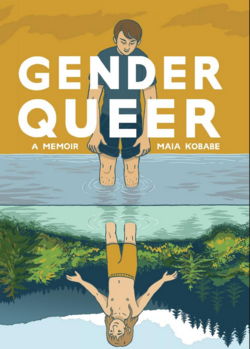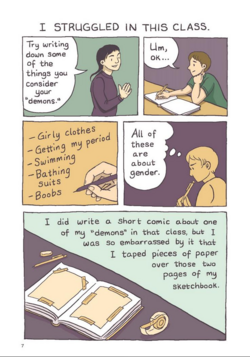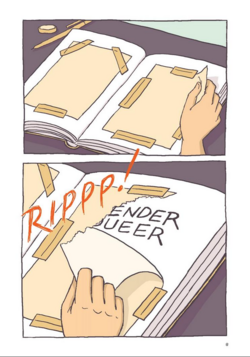Inatrous
kiwifarms.net
- Joined
- Dec 16, 2019
I first became aware of this vastly overrated Tumblr scrawl a few years ago, and after thinking over it a bit, thought it might be fun for a let's read. So join me, as we follow one woman's journey through the tomboy destroying pipeline of gender-identity and homoerotica, hopefully with a laugh or two along the way.
(Part 1)

The cover, like it's contents, is a badly drawn, poorly thought out, performative attempt at earnesty. The two central figures, both of whom are Maia, are each outlined in a deep, shaky blue, which stands out obnoxiously against the hair and face, while nearly vanishing against older Maia's shirt and pants. The line weight itself varies little--You'll notice the lines defining the kneecaps are about the same thickness as the ones used to outline her figure, and the leg-hair is only slightly thinner than that.
Typically, line weight is often varied, especially in comics, because it makes figures feel more dynamic and helps draw the eye to certain details while diminishing others. The reader gains nothing from being forced to oggle Maia's poorly shaded knees, but she obviously lacks the ability to intelligently guide the eye through a peice. After having read through the comic, in fact, I wouldn't be surprised if Maia was the sort to blame the reader for not looking where she wants, regardless of where her design is actually guiding them to go.
That would certainly explain why one of the most eye-catching parts of the cover is a young Maia's bright yellow shorts. Either that, or for some reason she actually wants me to stare at her crotch.
I'm also not a huge fan of how the linework is not consistent throughout the piece. In the upper panel, you'll notice that the blue outlines are only used for older Maia, then switched out for a pale blue to define the water in the midground, before swapping to a lineless style for the background, which is...I think an afternoon sky?
Contrast this to the lower panel, were that same blue outline is used to define both the foreground figure (young Maia), and the midground figures, strongly outlining several trees, which in turn define a pool, eschewing the white outline used to define the water in the upper panel for a more realistic technique of using the shadows cast by the forest to emphasize the edge. Then, because consistency is cisgender, immediately switches to a lineless style for the trees, before switching to outlines AGAIN for the clouds and mountains.
This probably seems rather nitpicky, but keep in mind that Maia isn't some random, this woman is a paid, published professional with an MA in comic design. She's supposed to know what she's doing. And if you happen to be an artist whose going for a deliberate mirror image/contrast setup, one of the things you're supposed to make sure of is that the two images differ only where they're meant to. Regular readers might not consciously pick on stuff like borked outlines or bad color choices, but other artists absolutely will. The level of thoughtlessness here, on what should be the best and most attention-grabbing version of her work, is astounding.
As a final smack to the face, a book that's all about how the author is supposedly neither male nor female somehow missed the chance to divide the title between the two panels while sticking the author's name right in between. I mean come on, that one should be a gimme.
I promise not to rant too hard about all the ways Maia is terrible at her job from here on out, but I just really needed to get that out of my system.
Part 1: Introduction


BEHOLD! GENDER QUEER!
(Part 1)

The cover, like it's contents, is a badly drawn, poorly thought out, performative attempt at earnesty. The two central figures, both of whom are Maia, are each outlined in a deep, shaky blue, which stands out obnoxiously against the hair and face, while nearly vanishing against older Maia's shirt and pants. The line weight itself varies little--You'll notice the lines defining the kneecaps are about the same thickness as the ones used to outline her figure, and the leg-hair is only slightly thinner than that.
Typically, line weight is often varied, especially in comics, because it makes figures feel more dynamic and helps draw the eye to certain details while diminishing others. The reader gains nothing from being forced to oggle Maia's poorly shaded knees, but she obviously lacks the ability to intelligently guide the eye through a peice. After having read through the comic, in fact, I wouldn't be surprised if Maia was the sort to blame the reader for not looking where she wants, regardless of where her design is actually guiding them to go.
That would certainly explain why one of the most eye-catching parts of the cover is a young Maia's bright yellow shorts. Either that, or for some reason she actually wants me to stare at her crotch.
I'm also not a huge fan of how the linework is not consistent throughout the piece. In the upper panel, you'll notice that the blue outlines are only used for older Maia, then switched out for a pale blue to define the water in the midground, before swapping to a lineless style for the background, which is...I think an afternoon sky?
Contrast this to the lower panel, were that same blue outline is used to define both the foreground figure (young Maia), and the midground figures, strongly outlining several trees, which in turn define a pool, eschewing the white outline used to define the water in the upper panel for a more realistic technique of using the shadows cast by the forest to emphasize the edge. Then, because consistency is cisgender, immediately switches to a lineless style for the trees, before switching to outlines AGAIN for the clouds and mountains.
This probably seems rather nitpicky, but keep in mind that Maia isn't some random, this woman is a paid, published professional with an MA in comic design. She's supposed to know what she's doing. And if you happen to be an artist whose going for a deliberate mirror image/contrast setup, one of the things you're supposed to make sure of is that the two images differ only where they're meant to. Regular readers might not consciously pick on stuff like borked outlines or bad color choices, but other artists absolutely will. The level of thoughtlessness here, on what should be the best and most attention-grabbing version of her work, is astounding.
As a final smack to the face, a book that's all about how the author is supposedly neither male nor female somehow missed the chance to divide the title between the two panels while sticking the author's name right in between. I mean come on, that one should be a gimme.
I promise not to rant too hard about all the ways Maia is terrible at her job from here on out, but I just really needed to get that out of my system.
Part 1: Introduction
- After finally opening up the cover, we are introduced to our brave, be-pronouned protagonist, packing her car as she gets ready to head off to school and earn her master's degree, from which she will learn nothing.
- Also, the lettering is slightly crooked in every single panel and it's driving me insane. I know Maia's going for that hand-lettered, personal diary look, but it reads as one more obnoxious, saccharine little flair trying to distract me from how lazy this work actually is.
- We then skip to Maia in a biography class, in which she's ill tempered at being encouraged to share personal, unpleasant secrets as part of her class project.
- This determination lasts exactly one page, which is a pity, because I actually agree with her her here. Teachers who try to get their students to share things like that is, at an absolute minimum, slightly shitty, biographical focus or no.

- Maia decides everything she's written down is related to gender, because swimming is for girls, I guess.
- Maia is too fragile to handle the sight of her own squiggles, until--

BEHOLD! GENDER QUEER!

















